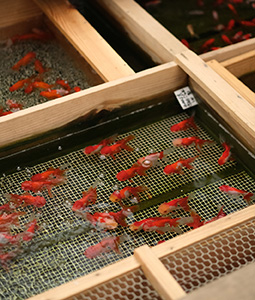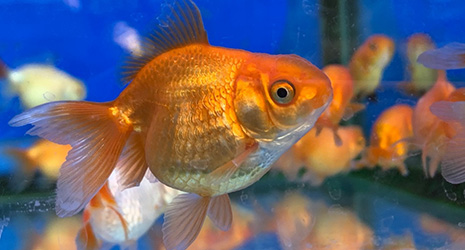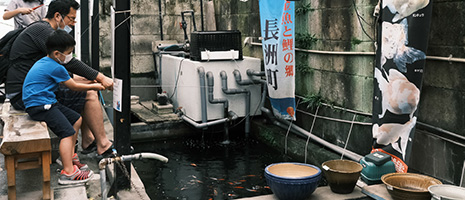
More than forty types of goldfish are cultivated in the outdoor aquariums
July 2020
The Enduring Charm of Goldfish Hill

Tokyo has a lot of hills. There are more than 800 places whose names include the word saka, meaning slope, within Tokyo’s twenty-three wards. One such place is Kingyozaka in Hongo, Bunkyo City, which derives its name from a goldfish (kingyo) wholesaler that began operations about 350 years ago. Goldfish, which are one of the charms of summer in Tokyo, swing their tails elegantly in this corner of the quiet residential district even today.

Across many years, many Japanese people have loved colorful swimming goldfish. Tokyo was a major goldfish producer beginning in the Edo period (1603–1867). But, as the city developed during the period of rapid economic growth in the latter part of the twentieth century, fish farmers closed their businesses one after another, or moved to Saitama or Ibaraki Prefectures on the periphery of Tokyo, leaving only a few wholesalers behind. One of those remaining is Kingyozaka (meaning Goldfish Hill), also known as Yoshida Seisuke Store, a goldfish wholesaler with 350 years of history, which still exists in Hongo in Tokyo’s Bunkyo City.
Kingyozaka is located partway down a narrow slope off the main road close to the Hongo Campus of the University of Tokyo. The rivers have been moved underground today, but they used to run in the old days around here and there was also a big, approximately 2,600 m2 pond. They used that pond as a goldfish farm and got started as a goldfish wholesaler.
“The property of the University of Tokyo was the main Edo (now Tokyo) residence of the daimyo (lord) of the Kaga Domain (now Ishikawa Prefecture) at that time. Our first president supplied the daimyo with goldfish. We hear that those goldfish were used as testers for poison in food for the lords as well as for ornamental purposes,” says Yoshida Tomoko, the seventh president of the company. Goldfish were introduced to Japan from China in the Muromachi period (1336–1573). At that time goldfish were cultivated by only the privileged classes as a very rare, precious ornamental fish. During the Bunka Bunsei years (1804–1829) of the Edo period, it became possible to mass-produce goldfish due to improvements in farming techniques, which led to lower prices. Hawkers sold goldfish by carrying a water tub around with goldfish in it. Then goldfish became popular pets and “goldfish hawker” came into use as a summer kigo (seasonal word) in traditional forms of Japanese poetry. The ukiyo-e woodblock prints of that time show that many people enjoyed goldfish.
Currently, Kingyozaka purchases goldfish from farms and markets at home and abroad and wholesales them nationwide, with its fish ranging from those used in goldfish-catching games at festivals to ornamental ones. Yoshida, who took over the business when her husband passed away in 2000, opened Café Kingyozaka at the same time, starting to retail to ordinary people as well as wholesaling to further promote goldfish culture.
Yoshida says, “As a goldfish wholesaler, we make water noise, so we used to enclose the pond with a tall fence. That is why no one came in. But considering that we have this place in the center of Tokyo and hoping that it can be a place that people love and where they can enjoy seeing goldfish, we renovated the old pond into a café.”
The interior of the café furnished with wood gives off a warm atmosphere. Goldfish swimming in tanks and miscellaneous items featuring goldfish can be found everywhere you look.
More than forty types of goldfish are cultivated in the outdoor aquariums, and people are welcome to come see them—and even catch them. The café is alive with families and couples on holidays.

Yoshida says, “We have many customers from abroad. I always say to customers who come to our café, ‘Please enjoy viewing goldfish.’ We have many types of goldfish and we never get tired of seeing them swim. I hope that as many people as possible come to know the charms of these goldfish.”
Yoshida says, “Probably because the district has been loved by intellectuals for many years, I see many quiet and polite people. They do not behave arrogantly because they are regular customers. There are many people who have the spirit of working together to foster a shop that they love. That’s the appeal of Hongo.”
Through her shop and café, Yoshida hopes to pass down traditional goldfish culture, which has lasted since the Edo period, to future generations. Goldfish enthusiasts, those who empathize with Yoshida’s wishes, and people who simply want to relax gather on Goldfish Hill today just as they did in the days of Edo.

